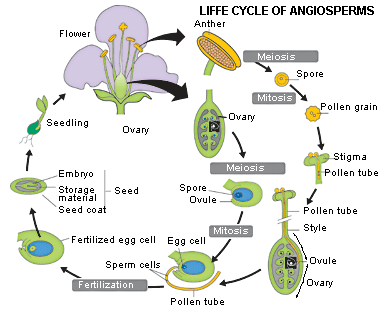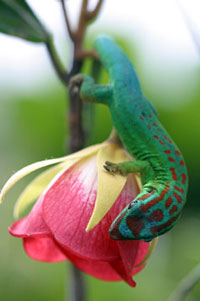To Pollinate or Not to Pollinate?
- Christina Dendy
- Sep 1, 2022
- 5 min read
That is NOT the question! Pollination is essential to the survival of flowering plants, which makes it essential to the survival of countless animals, including us. Angiosperms, or flowering plants, evolved about 140 million years ago. That's close (if you consider 5 million years shy to be "close") to the start of the Cretaceous period, the last age of the dinosaurs, which itself lasted nearly (if you consider 1 million years shy to be "nearly") 80 million years. Before that, gymnosperms, particularly the coniferous kind, ruled Earth ... along with the dinosaurs, pterosaurs, ichthyosaurs, plesiosaurs, and mosasaurs. (If you're not sure why I distinguished those, then come back and click on the link to find out.)
Why does any of that matter? Well, today, angiosperms make up about 90% of plant life on Earth, and as you might know, plant life definitely matters. Plants not only keep individual ecosystems running but also sustain the biosphere itself. All animals, directly or indirectly, rely on plants for their survival. They eat them, or they eat animals that eat plants. They breathe the oxygen released by plants during photosynthesis. Also, they're nice to look at. Some are even nice to smell or tickle your fingers through. Many have edible parts and even medicinal properties that are beneficial when used in knowledgeable, appropriate ways. In short, flowering plants rock! Well, actually, they flower, which is WHY I'm writing about pollinators.
Wait! Pollinators? Yes, pollinators! You see, flowering plants reproduce, or make more of themselves, through a process called pollination. Some can self-pollinate but most require the help of pollinators. Those are critters like insects as well as slugs and snails, bats, hummingbirds, certain rodents and others that move pollen from one part of a plant to another or from one plant to another. Getting the pollen where it needs to be sets off the process of reproduction, which translates to more flowering plants. No pollinators means no pollination means no flowering plants means, eventually, no us. A future without flowers looks pretty drab, in more ways than one.
So, why am I writing this again? Am I trying to persuade you that you should like bees even though some of them sting? Well, no. Wait, yes, you should appreciate and be thankful to bees even if some of them sting, and I say that as someone who swells up like a cabbage when she gets stung. But that's just part of it. Recently, the International Union for the Conservation of Nature (IUCN) declared migratory monarch butterflies to be endangered. That means they're at risk of going extinct, or dying out completely. Guess what? Monarch butterflies are impressive, beautiful insects that also happen to be important pollinators in North America.
And they're not alone in the endangered department.
Other pollinators are endangered or becoming increasingly rare, too. You might have heard people expressing concern about a decline in hospitable habitats for bees, which yes, you should like even if some of them sting. You see, the more natural spaces humans eliminate to make way for other things, the harder it gets for animals that live in those areas to survive. That includes many pollinators, including the largest one, the black-and-white ruffed lemur, which is native to Madagascar, an island nation off the coast of East Africa that is home to so much remarkable wildlife that it had an animated movie (or three?) made about it.
So, monarchs. Each spring, monarchs in Mexico start winging it northward in one of the longest relay-races ever. They stop in breeding grounds in Texas (and other warm nearby spots), mate, and lay eggs on milkweed plants. Those eggs hatch and produce caterpillars, who eat lots of milkweed and then hunker down in their chrysalis before emerging as butterflies themselves. Then, those butterflies continue north and repeat the process through several generations. The butterflies that end up 2,000 to 3,000 miles north in Canada then turn around in the fall and fly all the way back to warmer weather in central Mexico where they spend the winter in oyamel fir trees.

Pretty cool, huh? Yes, except that lots of human development and other activities plus climate change (ahem, caused by human development and other activities) are messing with their migration. Deforestation and other habitat loss to farming, industry, residential and commercial construction, highways, and more reduce the plants that butterflies and other pollinators need to survive.
The good news is that we, which includes you, can help. Don't believe me? Check out this awesome story about Mikaila, a girl who got stung by a bee, became afraid of them, chose to learn about them, and then changed her mind and decided she liked and wanted to help them. She STARTED HER OWN BUSINESS and WROTE A BOOK and donates some of her earnings to support organizations that help protect honeybees while raising awareness about their importance. But you don't have to start a business or write a book to help pollinators, though you can. Remember what pollinators need? That's right! Flowering plants, like milkweed, which need them in turn. (That's symbiosis, friends.)
So, what might you do to help them out? Hmmm. You got it! Plant milkweed and other flowering plants that monarch butterflies like. Growing pollinator gardens is a great way to help the pollinators, the plants, and the planet, which also helps you. Cultivating natural spaces, reforesting, rewilding, these are all ways to help out your local, regional and global communities. Since moving to our home seven years ago, my husband has been working to return the landscape around our house to a more natural woodland garden that includes pollinator plants native to Ohio, the state in which we live. Among these are milkweed, goldenrod, lupine, lobelia, and foxglove. They not only draw and sustain lots of moths, butterflies, and bumblebees but also make for lovely spring to early summer woodland colors.
Follow these links for some more tips on how to help monarch butterflies and other pollinators:
Six Ways to Save Monarchs from the National Wildlife Federation
10 Ways to Save the Bees from the Bee Conservancy
Lots of information from Save Our Monarchs
How You Can Help Pollinators from the U.S. Fish and Wildlife Service
Pollinator Books
One of the best things you can do is cultivate a knowledge and appreciation for pollinators, gardens, and wild spaces. The best way to do that is to get out exploring, experiencing and enjoying them in person. Another good way is to read and share books about them. So, to that end, here are some of our favorite picture books about butterflies, moths, bees, and other pollinators as well as pollination. Usually, I like to share descriptions and images from individual books but this post has gotten rather long so I'm posting this list of pollinator books that I have on Bookshop.org:
Here's a story read-aloud video for one of them:
Oh! and a bilingual one, with singing:
Finally, Ana, the main character in our book The Wall and the Wild, loves gardening, which means she loves pollinators. Check out this fabulous illustration by Katie Rewse. How many pollinators can you find? Flip through the book and you'll see even more!

"Oh! pleasant, pleasant were the days,
The time, when, in our childish plays,
My sister Emmeline and I
Together chased the butterfly!
A very hunter did I rush
Upon the prey:—with leaps and springs
I followed on from brake to bush;
But she, God love her, feared to brush
The dust from off its wings."

























Comments